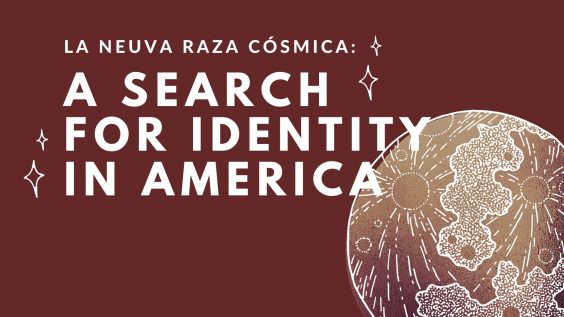La Nueva Raza Cósmica: A Search for Identity in America
by Brianna Austin / April 8, 2020 / Comments Off on La Nueva Raza Cósmica: A Search for Identity in America

“We in America shall arrive, before any part of the world, at the creation of a new race fashioned out of the treasures of all the previous ones: The final race, the cosmic race.”
— José Vasconcelos, “La raza cósmica” (“The Cosmic Race”)
America, some say, is part of “Western civilization,” a vague term alluding to Europe. Under this broad designation — where we deploy terms such as “the West” — there is a narrow understanding of who is American and who is not.
When you think of the phrase “American hero” or “Americans throughout history,” who do you think of? For many, their list may include the Founding Fathers, Abraham Lincoln, John F. Kennedy, or even Audie Murphy (if you’re a history buff). But what about Sylvia Riveria, Marcario García, or Henry B. González? Or what about the the Hispano men and women of the 1800s who settled much of the American Southwest, naming their cities and streets after Catholic saints? These people are all Americans and have performed heroic feats, yet their stories are so easily overlooked. Even when we acknowledge the cultural, historical, and societal impact of these communities, it’s still hammered into our zeitgeist that to be American is to be “white.”
In recent years, the term “Latinx” (pronounced “la-teen-ex”) has gained popularity among people of Latin American cultural or ethnic identity in the United States. It’s a term that embraces fluidity and unity across age, race, ethnicity, sexual orientation, and gender. Google Trend data reveals that the word first appeared in 2004 but began to enter the public conscience more broadly in 2014, particularly on social media. What’s empowering about the emergence of this new designation is that it was created by the people it describes for the people it describes. It was not affixed upon them by conquerors or by bureaucrats. For once, Latinx people have arrived at an opportunity to agitate the rigid narratives of whiteness and patriarchy.
From the very beginning, the notion of a Latin America was a European conception with a European identity imprinted upon it. Spain had a long, violent history of colonization in the Americas, Africa, and Asia, enslaving over a million people for more than 300 years. One of the most insidious aspects of the Spanish empire was their racialized caste system, or casta, which means “lineage” or “race.” Those who were Spanish-born were at the top of the social ladder followed by light-skinned mixed race people, indigenous people, and then Africans. To be Spanish meant social and economic privilege, while those who weren’t Spanish suffered from centuries of exploitation and dehumanization.
In the United States, there is still a harrowing need to categorize people, albeit not as horrific as the Spanish casta. One of the biggest perpetrators of this includes the Census Bureau. In 1930, “Mexican” was the first official term to account for the Latinx community but was limited to first- and second-generation Mexicans who weren’t “white, Negro, Indian, Chinese or Japanese.” In 1950 and 1960, their metrics included Spanish surnames, those who spoke Spanish as their “mother tongue,” and those of Mexican ancestry. Finally, the 1970 Census Bureau asked if Latinx people were “Mexican, Puerto Rican, Cuban, Central or South American, Other, Spanish,” or “No, none of these.” Of the 9.1 million Latinx folks in the United States at the time, an estimated one million people weren’t accounted for in the 1970 Census. And people were frustrated.
Several Latinx organizations filed a complaint to the U.S. Commission on Civil Rights demanding Congress for accurate representation. In 1976, the U.S. Congress passed Public Law 94-311, a law requiring the collection of “economic and social statistics for Americans of Spanish origin or descent.” The law lists a handful of countries to fall under the umbrella term “Spanish origin or descent,” excluding non-Hispanophone countries such as Belize, Brazil, and the Philippines. Apparently, government agencies don’t have depth perception because they keep falling into the “Spanish origin” abyss. Finally, the Census Bureau got out of the metaphorical ditch and added “Latino” to account for the non-Spanish speakers in 1997. After several iterations, the current question for 2020 reads, “Is this person of Hispanic, Latino, or Spanish origin?”
With bureaucratic history aside, there is an interesting conversation about the terms “Hispanic,” “Latino,” and “Latinx.” Most people use them interchangeably. However, the use of “Latinx” is a step forward, furthering a shared language and helping to disavow the term “Hispanic” and its ties to the cruel period of colonialism. “Hispanic” comes from the word Hispania, the Roman name for the Iberian Peninsula, which is now Spain and Portugal. Meanwhile, the Civil Rights Era saw the first emergence of post-colonial identity as people of color fought for equal rights and unity. Many activists called themselves “Latin,” which soon adapted to “Latino/a.” “Latinx” takes the next step as its gender neutrality includes the spectrum of identities of the LGBTQ+ community.
While there is contention of its use and the future use of “Latinx” may be uncertain, you can’t take away this power in choice that emerged in this moment in time. The term “Latinx” isn’t the product of the American government, academic elites, or white liberals. It was created by the people it describes. And this is precisely the point.
Brianna Austin is a staff writer.




